Dynamic Estimation of Formation Wake Flow Fields Based on On-Board Sensing
Highlights
- The PI-Model significantly improves the accuracy of wake velocity distribution estimation and formation aerodynamic effect prediction compared to theoretical models.
- In two-aircraft formations, the estimation error of the optimal position by the PI-Model remains within 1% of the wingspan, and the converged position of the algorithm enables a 15–25% drag reduction for the follower aircraft.
- This work provides a practical method for wake dynamics estimation in complex multi-aircraft formations, offering a feasible and low-cost approach for achieving fast and adaptive energy-efficient formation flight.
- The proposed PI-Model demonstrates feasibility for formation flight applications and can be extended to larger heterogeneous mixed fleets. It holds significant theoretical and engineering value for improving the energy efficiency and mission performance of future UAV swarms.
Abstract
1. Introduction
2. Wake Flow Field Estimation Method
- Flight Condition Assumption
- The aircraft is assumed to maintain steady level flight at a constant altitude.
- Flow Field Assumptions
- The freestream is assumed to be uniform.
- Turbulence and crosswinds are excluded from the simulation; the wake model is constructed under ideal, disturbance-free conditions.
- Ground effects are neglected due to the high flight altitude.
- Wake Dynamics Assumptions
- Structural deformation of the wake caused by external disturbances, as well as interactions between the wake and the ground, are not considered. The wake is assumed to remain stable within the simulation timescale.
- The influence of the follower aircraft on the wake field of the leader is not considered during the sensing process.
2.1. Aircraft Platform and Sensor Configuration
2.1.1. Aircraft Platform and Onboard Sensor
2.1.2. Sliding Window
2.2. Wake Flow Field Sensing Method
2.2.1. Velocity Triangle
2.2.2. High-Accuracy Wake Flow Field Sensing
- The proportional symmetric sampling method [38] is employed to obtain 2n + 1 sampling combinations (i.e., the Sigma points set), which are then organized in the following sequence:
- Substitute these 2n + 1 points into the state equation to obtain the step prediction for these points:where the subscript denotes a prior estimate of the state at time based on all the information available up to time .
- Based on the 2n + 1 predicted results, calculate the step predicted mean and the covariance matrix of the system state variables.where are the two types of weighting coefficients.
- Based on the predicted mean and covariance matrix, the UT (Unscented Transform) is applied again to generate a new set of 2n + 1 Sigma points.
- Substitute the point set into the observation equation to obtain the predicted observation at step .
- Based on the 2n + 1 predicted results, calculate the step predicted mean and the covariance matrix of the system’s observation variables.
- Calculate the Kalman gain.
- Finally, after obtaining the new measurement , update the system’s state and covariance.where the subscript denotes the posterior estimate of the state at time , after incorporating the measurement obtained at that same time.
2.3. Wake Vortex Field Estimation Method
2.3.1. PI-Model
2.3.2. Identification of Wake Vortex Parameters Through the IPIO
2.4. Formulation of Formation Aerodynamic Effect
2.4.1. Induced Lift Calculation
2.4.2. Induced Drag Calculation
2.4.3. Induced Rolling Moment Calculation
3. PI-Model Accuracy Verification
3.1. Velocity Accuracy Comparison
3.1.1. Vertical Induced Velocity Comparison
3.1.2. Lateral Induced Velocity Comparison
3.2. Formation Aerodynamic Effect Estimation Accuracy Comparison
3.2.1. Induced Lift Coefficient Comparison
3.2.2. Induced Drag Coefficient Comparison
3.2.3. Induced Rolling Moment Coefficient Comparison
3.3. Summary
4. Two-Aircraft Formation Simulation
- The leader aircraft maintains steady level flight with a speed of 10 m/s and an angle of attack of 5°.
- The freestream velocity is identical to the flight speed, and atmospheric turbulence effects are neglected.
- At the beginning of the formation, the follower aircraft has the same trimmed angle of attack and flight speed as the leader and subsequently maintains the trimmed angle of attack.
4.1. Simulation Environment and Process
4.2. Two-Aircraft Formation
4.2.1. Homogeneous Formation
4.2.2. Heterogeneous Formation
4.3. Result Discussion
- Real-time optimization is effective: In the above scenarios, the PI-Model based on onboard sensor wake identification, and the GD optimization algorithm both achieve stable convergence. This ensures that the follower aircraft quickly finds the optimal formation position, meeting the real-time formation control requirements and demonstrating potential for practical application.
- Position accuracy validation: CFD validation shows that the relative positions obtained using the proposed method result in drag reduction efficiencies of 15% and 25% under different conditions, respectively, compared to solo flight. The lateral steady-state error in position optimization is controlled within 1% of the wingspan, proving the algorithm’s satisfactory accuracy and effectiveness.
5. Conclusions
- The wake vortex estimation method, PI-Model, proposed in this paper, minimizes the wake-induced velocity residuals using the IPIO algorithm, enabling accurate identification of key wake vortex parameters and significantly enhancing the accuracy and versatility of wake velocity estimation. Compared to CFD results, the PI-Model improves the precision of wake field velocity sensing and formation aerodynamic effect estimation. Additionally, the PI-Model samples the real-time wake field using a multi-sensor system with two ADS units, ensuring high estimation performance while significantly reducing hardware and computational costs. This makes the method suitable for deployment on low-cost UAV platforms and demonstrates its potential for application in multi-UAV complex formation scenarios.
- PI-Model enables online estimation of parameters through real-time individual sensor feedback, providing “wake tracking” capability. Compared to other formation aerodynamic modeling methods, this approach allows for dynamic updates of wake changes, improving the accuracy of wake vortex estimation. In formation scenarios, this results in the continuous identification of the optimal position, thereby enhancing the aerodynamic benefits of the formation.
- The effectiveness of the wake vortex estimation and formation optimization methods is validated through the construction of a formation simulation. In various scenarios presented in this paper, the formation positions achieved stable convergence. Compared to solo flight, the drag reduction efficiency of the follower aircraft in the formation flight reached 15% and 25% under different conditions. CFD validation confirmed that the steady-state error at the converged position was controlled within 1% of the wingspan, demonstrating the satisfactory accuracy and effectiveness of the proposed method.
Author Contributions
Funding
Data Availability Statement
Conflicts of Interest
References
- Lissaman, P.B.S.; Shollenberger, C.A. Formation Flight of Birds. Science 1970, 168, 1003–1005. [Google Scholar] [CrossRef]
- Weimerskirch, H.; Martin, J.; Clerquin, Y.; Alexandre, P.; Jiraskova, S. Energy Saving in Flight Formation. Nature 2001, 413, 697–698. [Google Scholar] [CrossRef]
- Portugal, S.J.; Hubel, T.Y.; Fritz, J.; Heese, S.; Trobe, D.; Voelkl, B.; Hailes, S.; Wilson, A.M.; Usherwood, J.R. Upwash Exploitation and Downwash Avoidance by Flap Phasing in Ibis Formation Flight. Nature 2014, 505, 399–402. [Google Scholar] [CrossRef] [PubMed]
- Ray, R.; Cobleigh, B.; Vachon, M.; St. John, C. Flight Test Techniques Used to Evaluate Performance Benefits During Formation Flight. In Proceedings of the AIAA Atmospheric Flight Mechanics Conference and Exhibit, Monterey, CA, USA, 5–8 August 2002. [Google Scholar]
- Kent, T.E.; Richards, A.G. Analytic Approach to Optimal Routing for Commercial Formation Flight. J. Guid. Control Dyn. 2015, 38, 1872–1884. [Google Scholar] [CrossRef]
- Bangash, Z.A.; Sanchez, R.P.; Ahmed, A.; Khan, M.J. Aerodynamics of Formation Flight. J. Aircr. 2006, 43, 907–912. [Google Scholar] [CrossRef]
- Hanson, C.E.; Pahle, J.; Reynolds, J.R.; Andrade, S.; Nelson, B. Experimental Measurements of Fuel Savings During Aircraft Wake Surfing. In Proceedings of the 2018 Atmospheric Flight Mechanics Conference, Atlanta, GA, USA, 25–29 June 2018. [Google Scholar]
- Zhang, Q.; Liu, H.H.T. Robust Nonlinear Close Formation Control of Multiple Fixed-Wing Aircraft. J. Guid. Control Dyn. 2021, 44, 572–586. [Google Scholar] [CrossRef]
- Wang, R.; Zhou, Z.; Lungu, M.; Li, L. PSD INDI and Wake Gradient Based Control of High Aspect Ratio UAVs’ Close Formation Flight. Aerosp. Sci. Technol. 2025, 162, 110198. [Google Scholar] [CrossRef]
- Sheng, H.; Zhang, J.; Yan, Z.; Yin, B.; Liu, S.; Bai, T.; Wang, D. New Multi-UAV Formation Keeping Method Based on Improved Artificial Potential Field. Chin. J. Aeronaut. 2023, 36, 249–270. [Google Scholar] [CrossRef]
- Tao, Y.; Xiong, N.; Wang, X.; Lin, J.; Liu, Z.; Ma, S.; Wu, J. Experimental and Computational Investigation of Hybrid Formation Flight for Aerodynamic Gain at Transonic Speed. Chin. J. Aeronaut. 2021, 34, 32–43. [Google Scholar] [CrossRef]
- Yang, M.; Guan, X.; Shi, M.; Li, B.; Wei, C.; Yiu, K.-F.C. Distributed Model Predictive Formation Control for UAVs and Cooperative Capability Evaluation of Swarm. Drones 2025, 9, 366. [Google Scholar] [CrossRef]
- Martinez-Ponce, J.; Herkenhoff, B.; Aboelezz, A.; Urban, C.; Armanini, S.; Raphael, E.; Hassanalian, M. Studies on V-Formation and Echelon Flight Utilizing Flapping-Wing Drones. Drones 2024, 8, 395. [Google Scholar] [CrossRef]
- Yuan, G.; Duan, H. Robust Control for UAV Close Formation Using LADRC via Sine-Powered Pigeon-Inspired Optimization. Drones 2023, 7, 238. [Google Scholar] [CrossRef]
- Zhu, H.; Wu, S. Leader–Follower Formation Reconfiguration Control for Fixed-Wing UAVs Using Multiplayer Stackelberg–Nash Game. Drones 2025, 9, 439. [Google Scholar] [CrossRef]
- Ma, B.; Liu, Z.; Jiang, F.; Zhao, W.; Dang, Q.; Wang, X.; Zhang, J.; Wang, L. Reinforcement Learning Based UAV Formation Control in GPS-Denied Environment. Chin. J. Aeronaut. 2023, 36, 281–296. [Google Scholar] [CrossRef]
- Cho, J.; Lee, B.J.; Misaka, T.; Yee, K. Study on Decay Characteristics of Vertical Four-Vortex System for Increasing Airport Capacity. Aerosp. Sci. Technol. 2020, 105, 106017. [Google Scholar] [CrossRef]
- Kless, J.E.; Aftosmis, M.J.; Ning, S.A.; Nemec, M. Inviscid Analysis of Extended-Formation Flight. AIAA J. 2013, 51, 1703–1715. [Google Scholar] [CrossRef]
- Qiao, N.; Ma, T.; Wang, X.; Wang, J.; Fu, J.; Xue, P. An Approach for Formation Design and Flight Performance Prediction Based on Aerodynamic Formation Unit: Energy-Saving Considerations. Chin. J. Aeronaut. 2024, 37, 77–91. [Google Scholar] [CrossRef]
- Al-Mahadin, A.; Almajali, M. Simplified Mathematical Modelling of Wing Tip Vortices. In Proceedings of the 2019 Advances in Science and Engineering Technology International Conferences (ASET), IEEE, Dubai, United Arab Emirates, 26 March–10 April 2019; pp. 1–6. [Google Scholar]
- Cui, Y.; Lu, H.; Dong, X.; Xiang, J.; Li, D.; Tu, Z. Air–Ground Cooperative Multitarget Hierarchical Tracking Method Based on Aerial Fisheye View. IEEE Trans. Syst. Man Cybern. Syst. 2025, 1–12. [Google Scholar] [CrossRef]
- Brodecki, M.; Subbarao, K. Autonomous Formation Flight Control System Using In-Flight Sweet-Spot Estimation. J. Guid. Control Dyn. 2015, 38, 1083–1096. [Google Scholar] [CrossRef]
- Melin, T. A Vortex Lattice MATLAB Implementation for Linear Aerodynamic Wing Applications; Royal Institute of Technology: Stockholm, Sweden, 2000. [Google Scholar]
- Peristy, L.H.; Perez, R.E.; Jansen, P.W. Wake Modelling with Embedded Lateral and Directional Stability Sensitivity Analysis for Aerial Refuelling or Formation Flight. In Proceedings of the AIAA Scitech 2019 Forum, San Diego, CA, USA, 7–11 January 2019. [Google Scholar]
- Zhang, Q.; Liu, H.H.T. Aerodynamics Modeling and Analysis of Close Formation Flight. J. Aircr. 2017, 54, 2192–2204. [Google Scholar] [CrossRef]
- Yuan, G.; Xia, J.; Duan, H. A Continuous Modeling Method via Improved Pigeon-Inspired Optimization for Wake Vortices in UAVs Close Formation Flight. Aerosp. Sci. Technol. 2022, 120, 107259. [Google Scholar] [CrossRef]
- Unterstrasser, S.; Stephan, A. Far Field Wake Vortex Evolution of Two Aircraft Formation Flight and Implications on Young Contrails. Aeronaut. J. 2020, 124, 667–702. [Google Scholar] [CrossRef]
- Edstrand, A.M.; Davis, T.B.; Schmid, P.J.; Taira, K.; Cattafesta, L.N. On the Mechanism of Trailing Vortex Wandering. J. Fluid Mech. 2016, 801, R1. [Google Scholar] [CrossRef]
- Lin, M.; Huang, W.; Zhang, Z.; Xu, C.; Cui, G. Numerical Study of Aircraft Wake Vortex Evolution near Ground in Stable Atmospheric Boundary Layer. Chin. J. Aeronaut. 2017, 30, 1866–1876. [Google Scholar] [CrossRef]
- Pan, W.; Deng, L.; Leng, Y.; Li, F. Wake Vortex Safety Assessment during Cruise Using a Regional Medium-Short-Range Turbofan Aircraft as an Example. Chin. J. Aeronaut. 2025, 38, 103283. [Google Scholar] [CrossRef]
- Michel, D.T.; Dolfi-Bouteyre, A.; Goular, D.; Augère, B.; Planchat, C.; Fleury, D.; Lombard, L.; Valla, M.; Besson, C. Onboard Wake Vortex Localization with a Coherent 1.5 Μm Doppler LIDAR for Aircraft in Formation Flight Configuration. Opt. Express 2020, 28, 14374. [Google Scholar] [CrossRef]
- Wei, Z.; Lu, T.; Gu, R.; Liu, F. DBN-GABP Model for Estimation of Aircraft Wake Vortex Parameters Using Lidar Data. Chin. J. Aeronaut. 2024, 37, 347–368. [Google Scholar] [CrossRef]
- Rodenhiser, R.J.; Durgin, W.W.; Johari, H. Ultrasonic Method for Aircraft Wake Vortex Detection. J. Aircr. 2007, 44, 726–732. [Google Scholar] [CrossRef]
- Hallock, J.N.; Holzäpfel, F. A Review of Recent Wake Vortex Research for Increasing Airport Capacity. Prog. Aerosp. Sci. 2018, 98, 27–36. [Google Scholar] [CrossRef]
- Steen, M.; Hecker, P. Investigating the Potential Future Usage of Combined Airborne Wake Vortex Prediction Models and Measurement Sensors. In Proceedings of the 2018 Atmospheric and Space Environments Conference, Atlanta, GA, USA, 25–29 June 2018. [Google Scholar]
- Di, W.; Dang, S.; Gong, Z.; Zhang, J.; Xiang, J.; Jiang, Y.; Li, D.; Tu, Z. Skin-Like Airflow Odometry for Micro Aerial Vehicles Based on Distributed Thermal Anemometers. Adv. Intell. Syst. 2025, 2500406. [Google Scholar] [CrossRef]
- DeVries, L.; Paley, D.A. Wake Sensing and Estimation for Control of Autonomous Aircraft in Formation Flight. J. Guid. Control Dyn. 2016, 39, 32–41. [Google Scholar] [CrossRef]
- Julier, S.J. A Skewed Approach to Filtering. In Proceedings of the Aerosense: The 12th International Symposium on Aerospace/Defense Sensing, Simulation and Controls, Orlando, FL, USA, 14–16 April 1998. [Google Scholar]
- Holzäpfel, F. Probabilistic Two-Phase Wake Vortex Decay and Transport Model. J. Aircr. 2003, 40, 323–331. [Google Scholar] [CrossRef]
- Burnham, D.C.; Hallock, J.N. Chicago Monostatic Acoustic Vortex Sensing System; U.S. Department of Transportation: Washington, DC, USA, 1982; p. 206.
- Kurylowich, G. A Method for Assessing the Impact of Wake Vortices on USAF Operations; Air Force Flight Dynamics Laboratory: Wright-Patterson Air Force Base, OH, USA, 1979. [Google Scholar]
- Yuan, G.; Duan, H. Extremum Seeking Control for UAV Close Formation FLight via Improved Pigeon-Inspired Optimization. Sci. China Technol. Sci. 2024, 67, 435–448. [Google Scholar] [CrossRef]



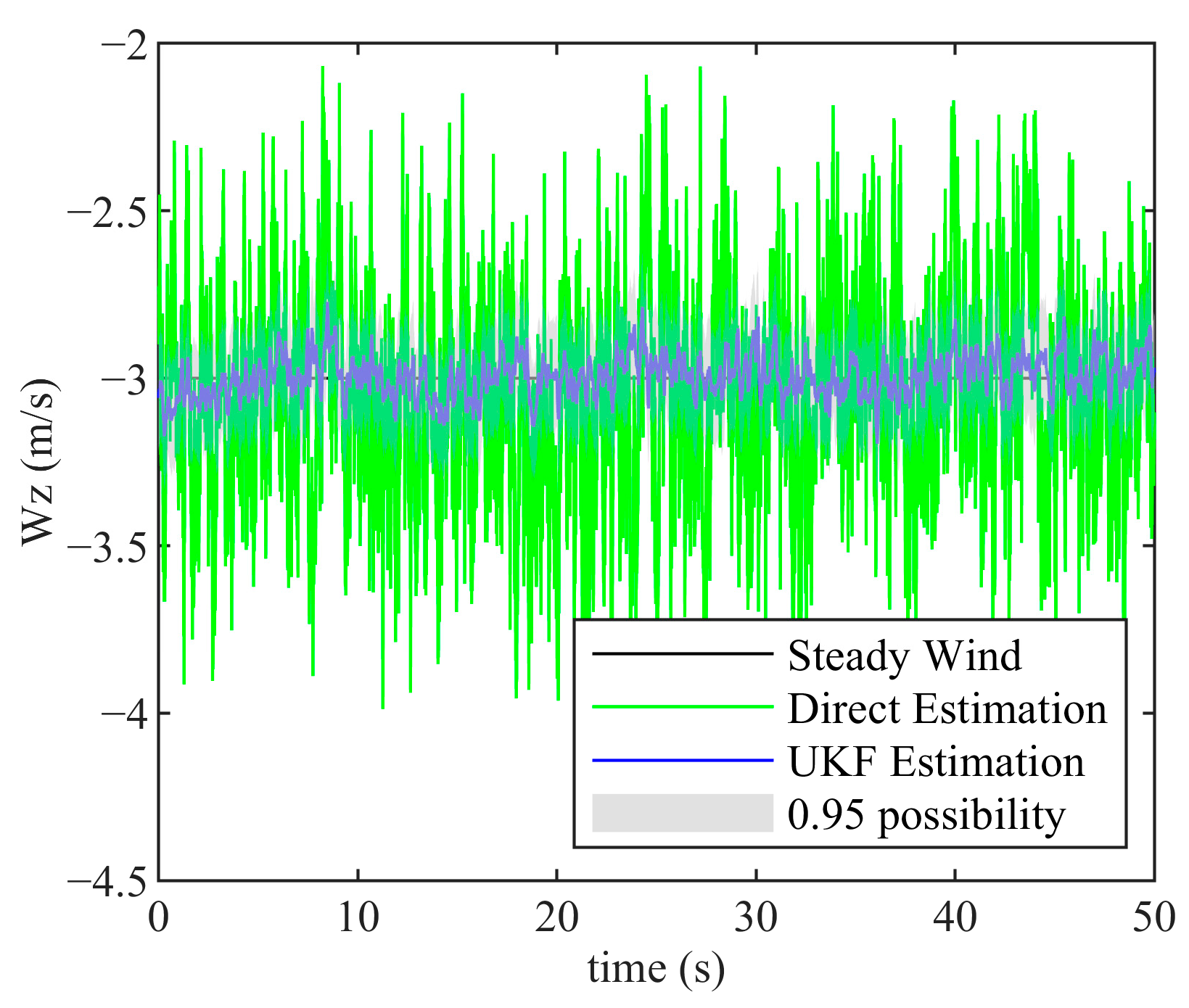
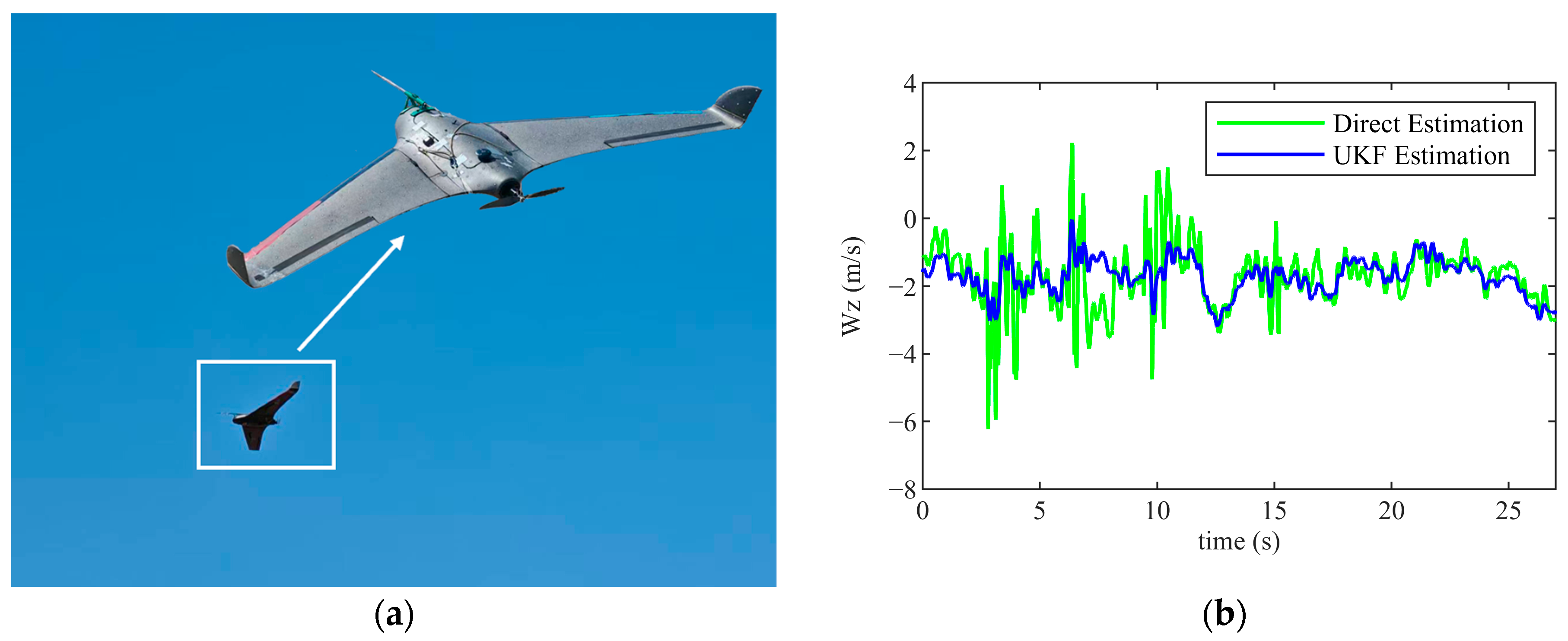
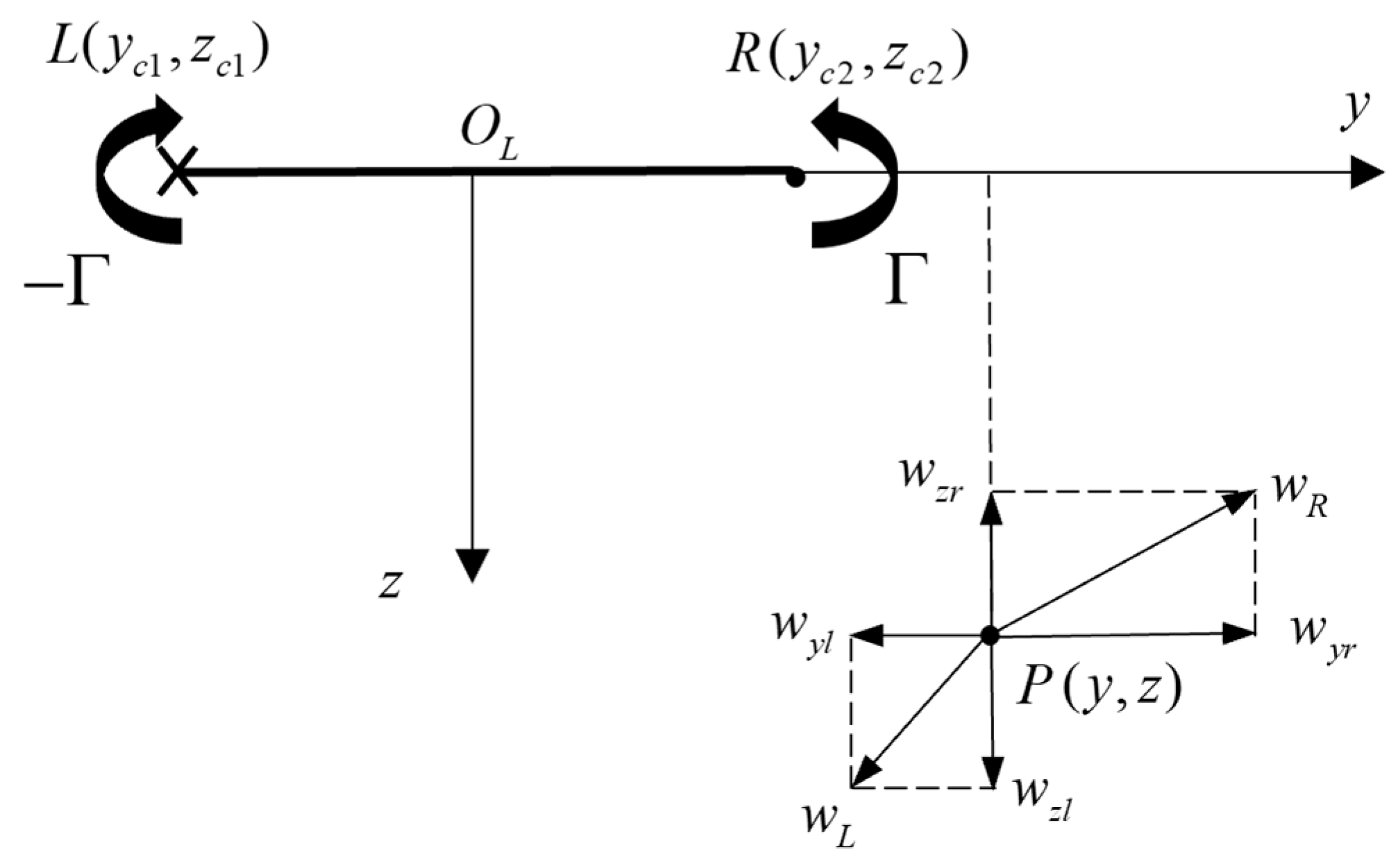
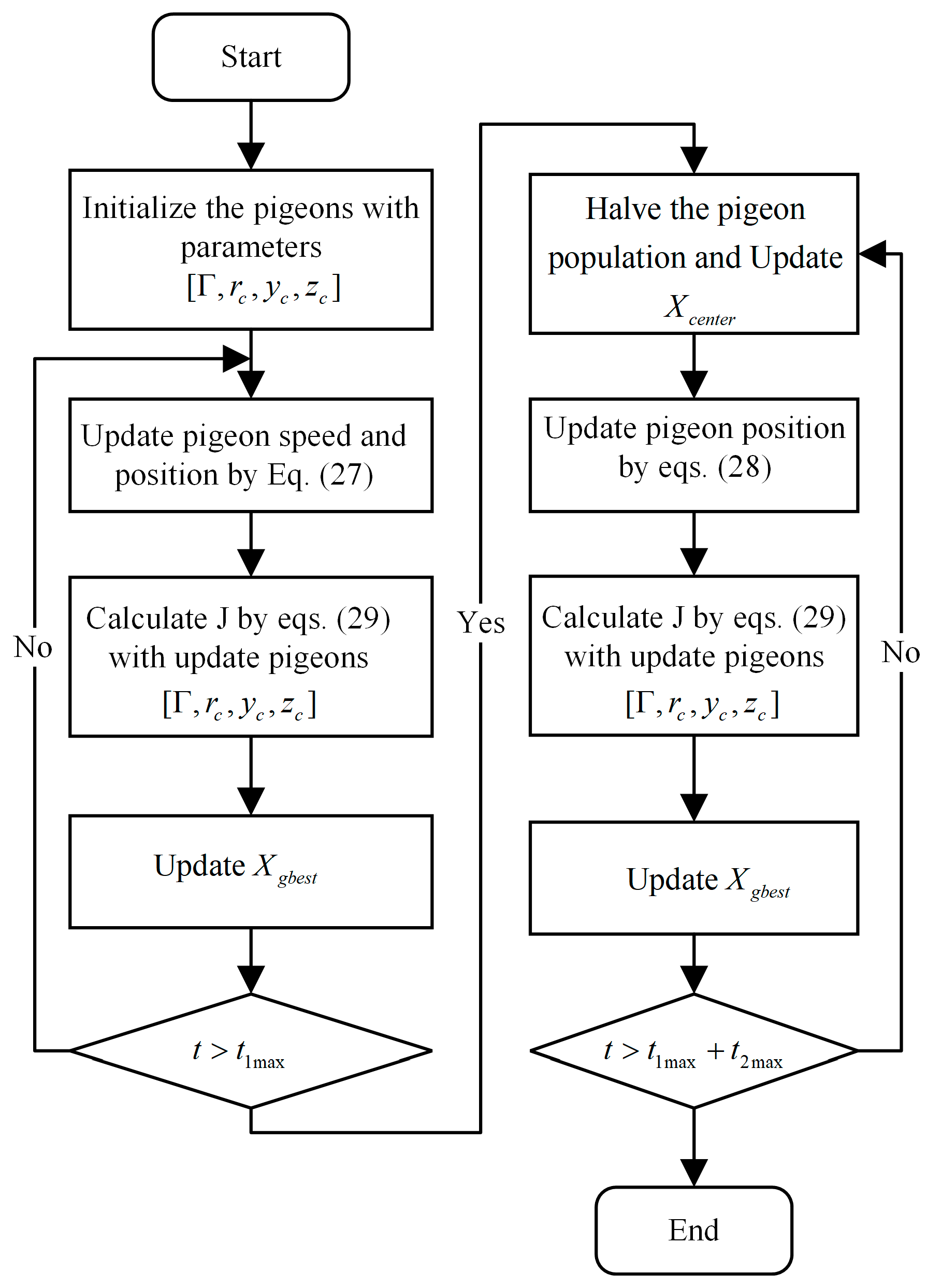
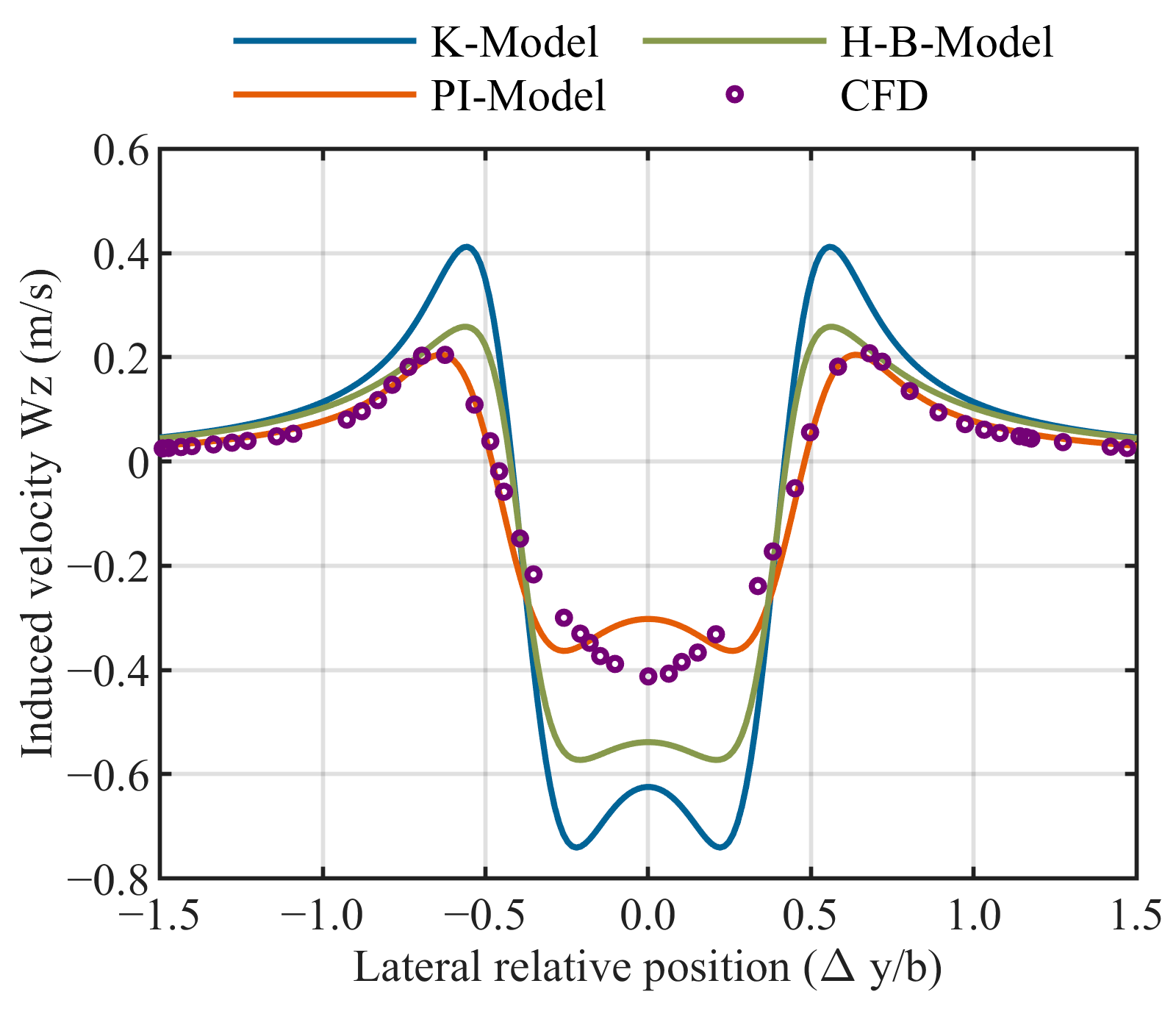
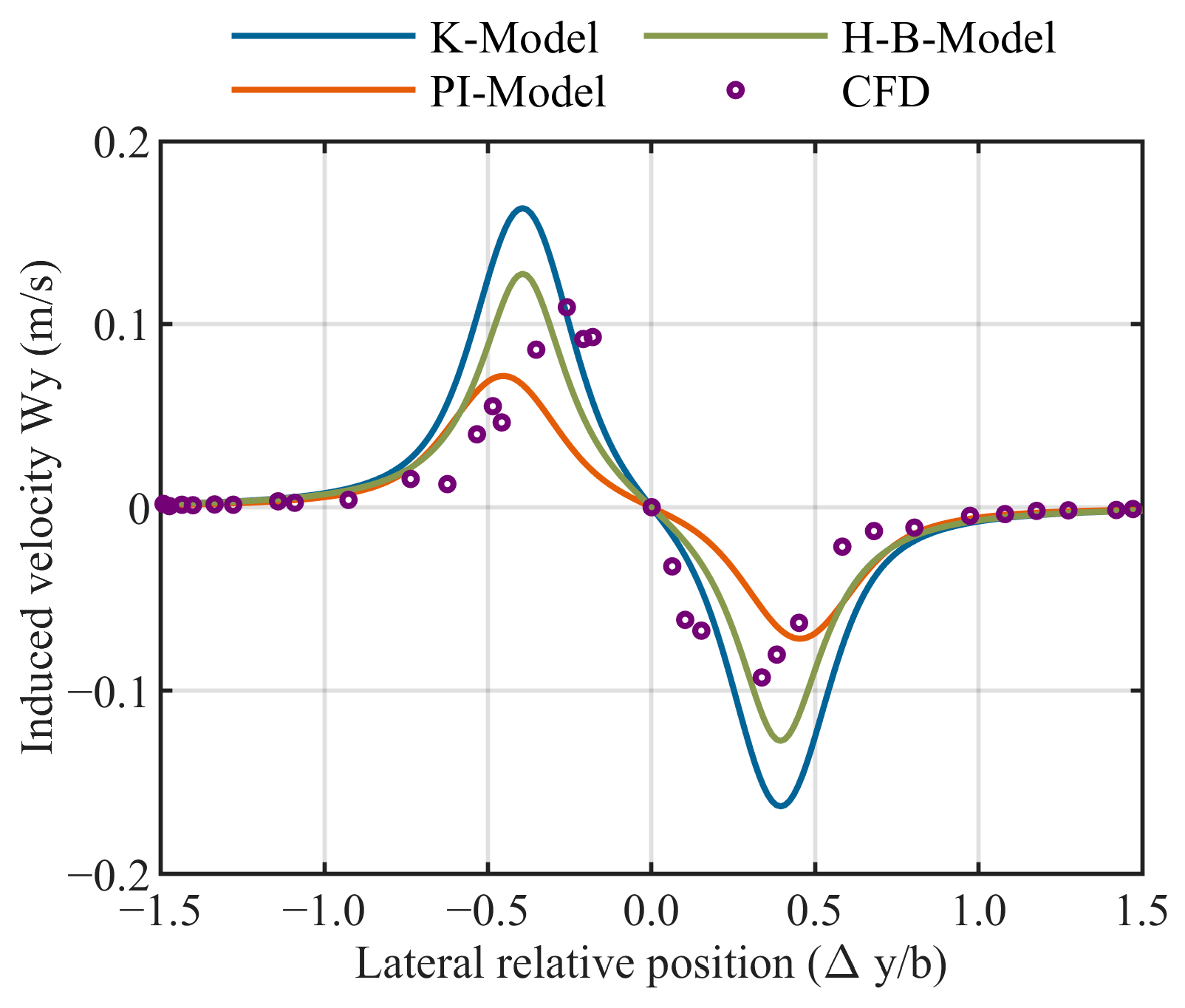
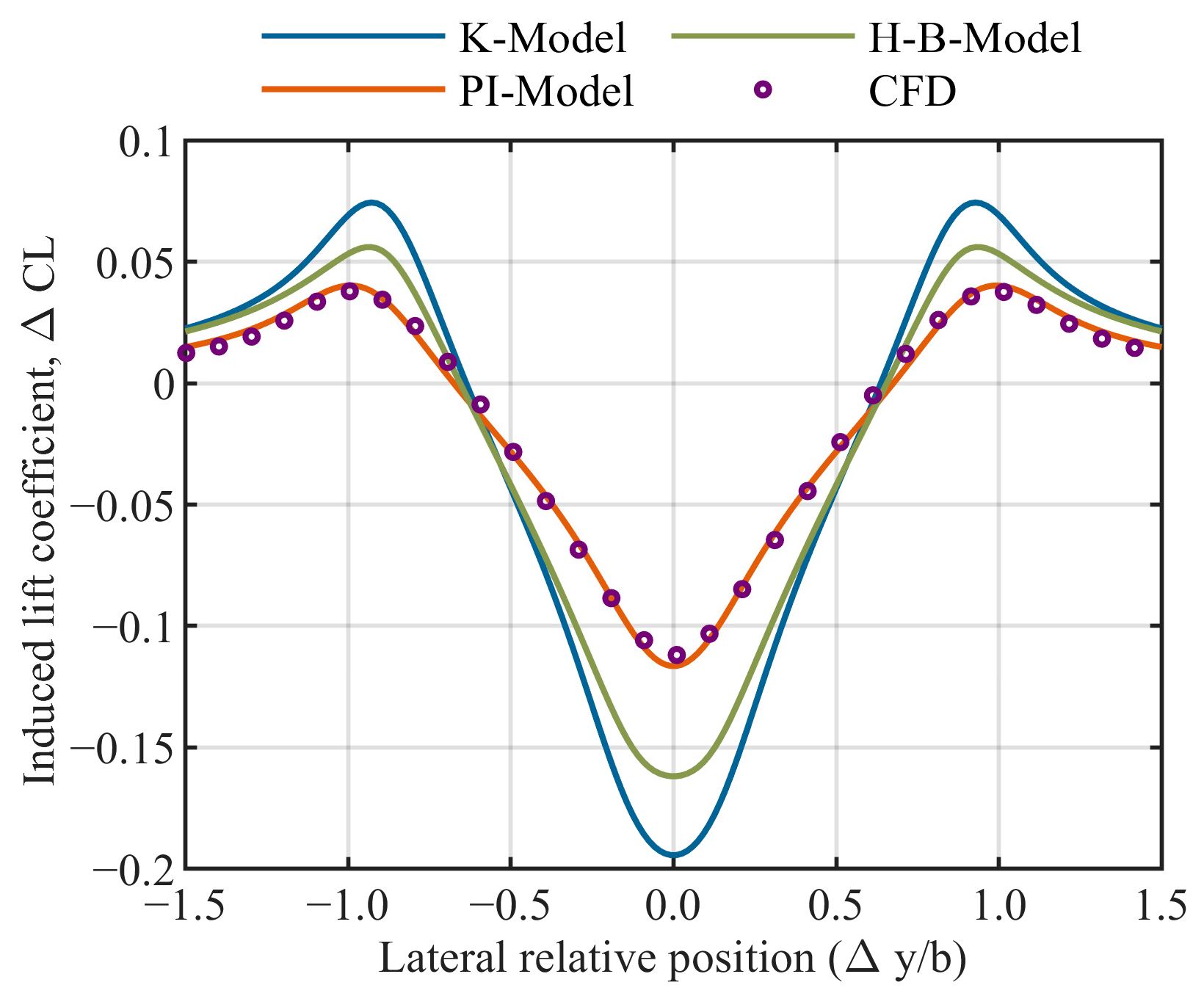

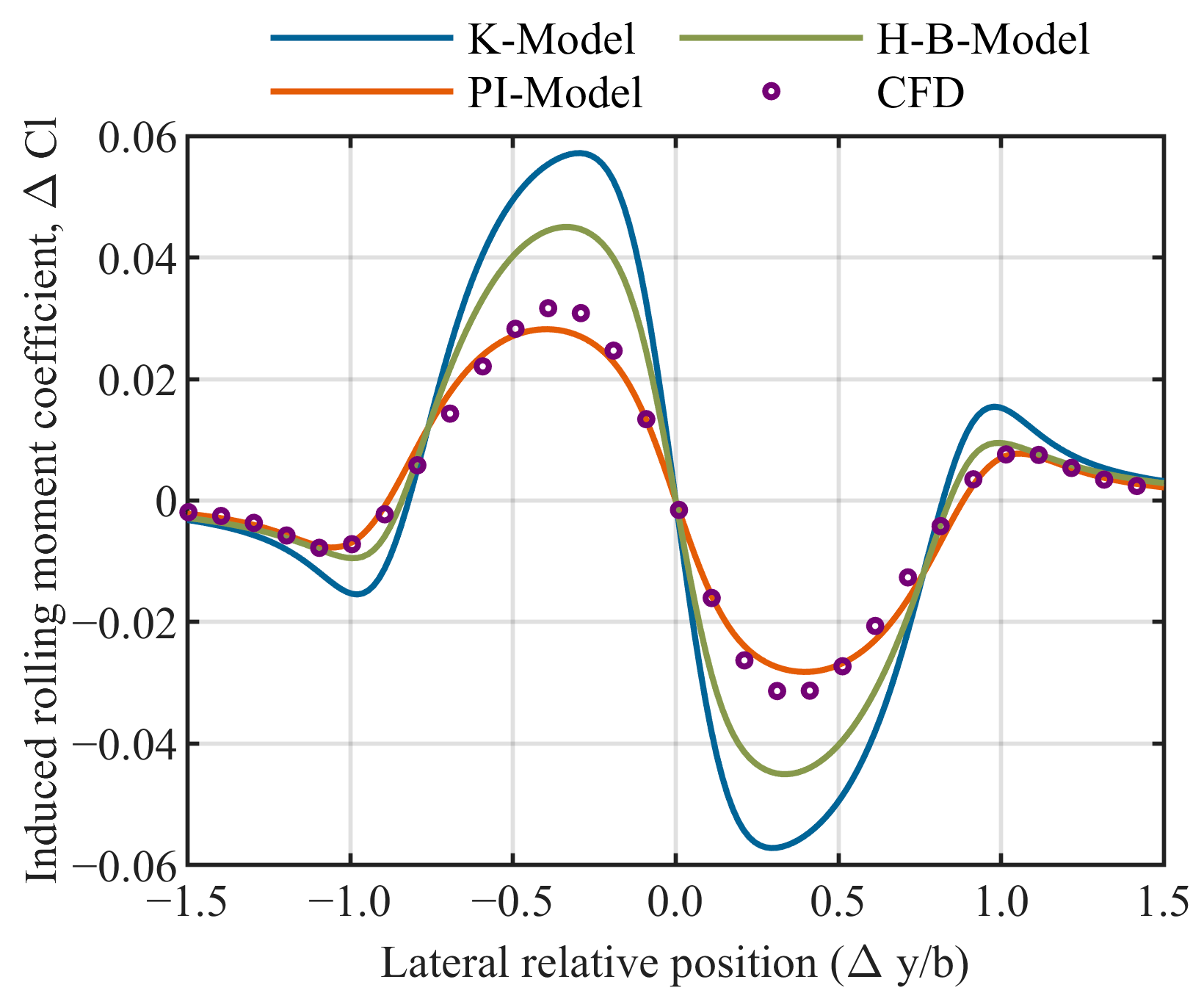




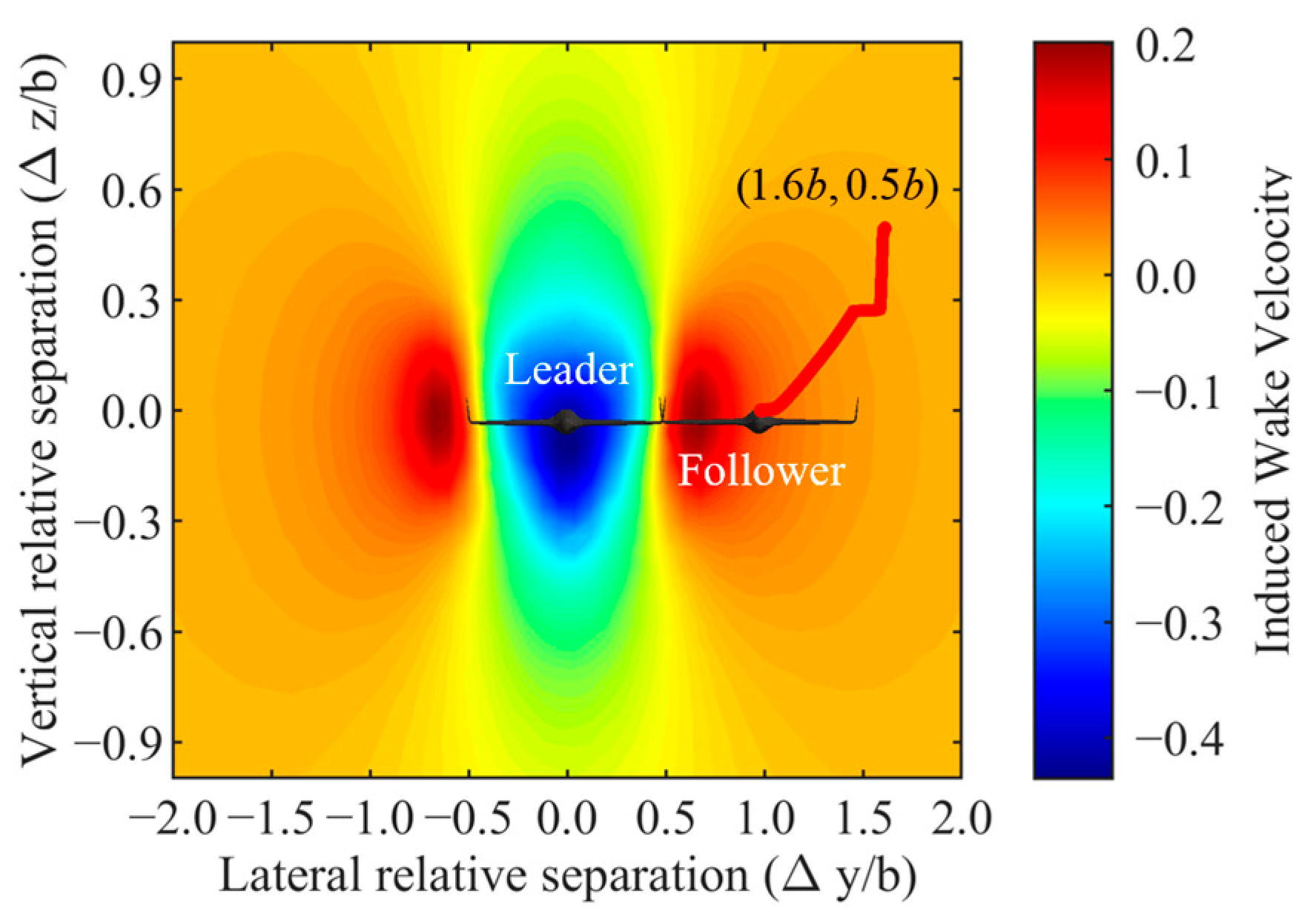

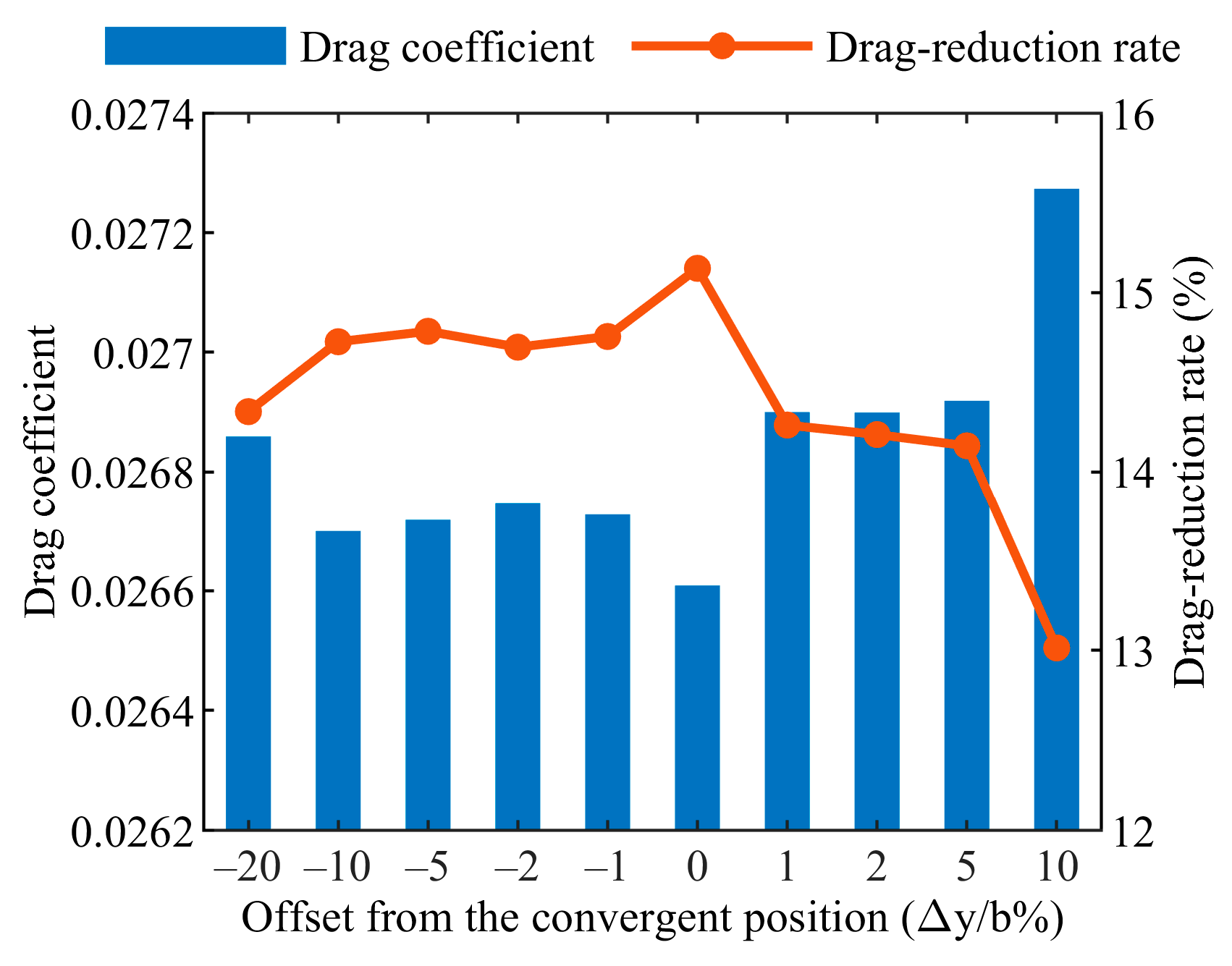

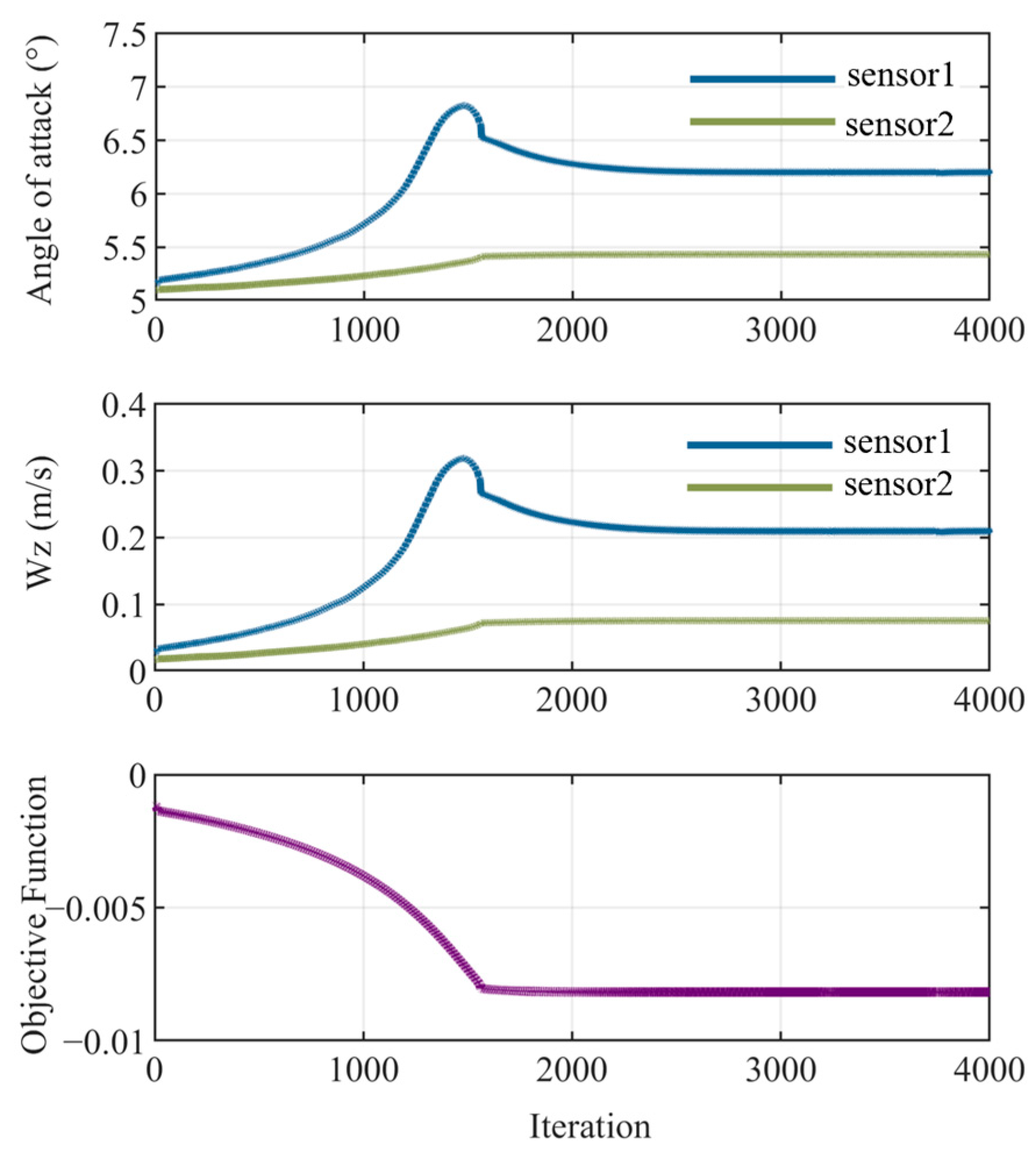
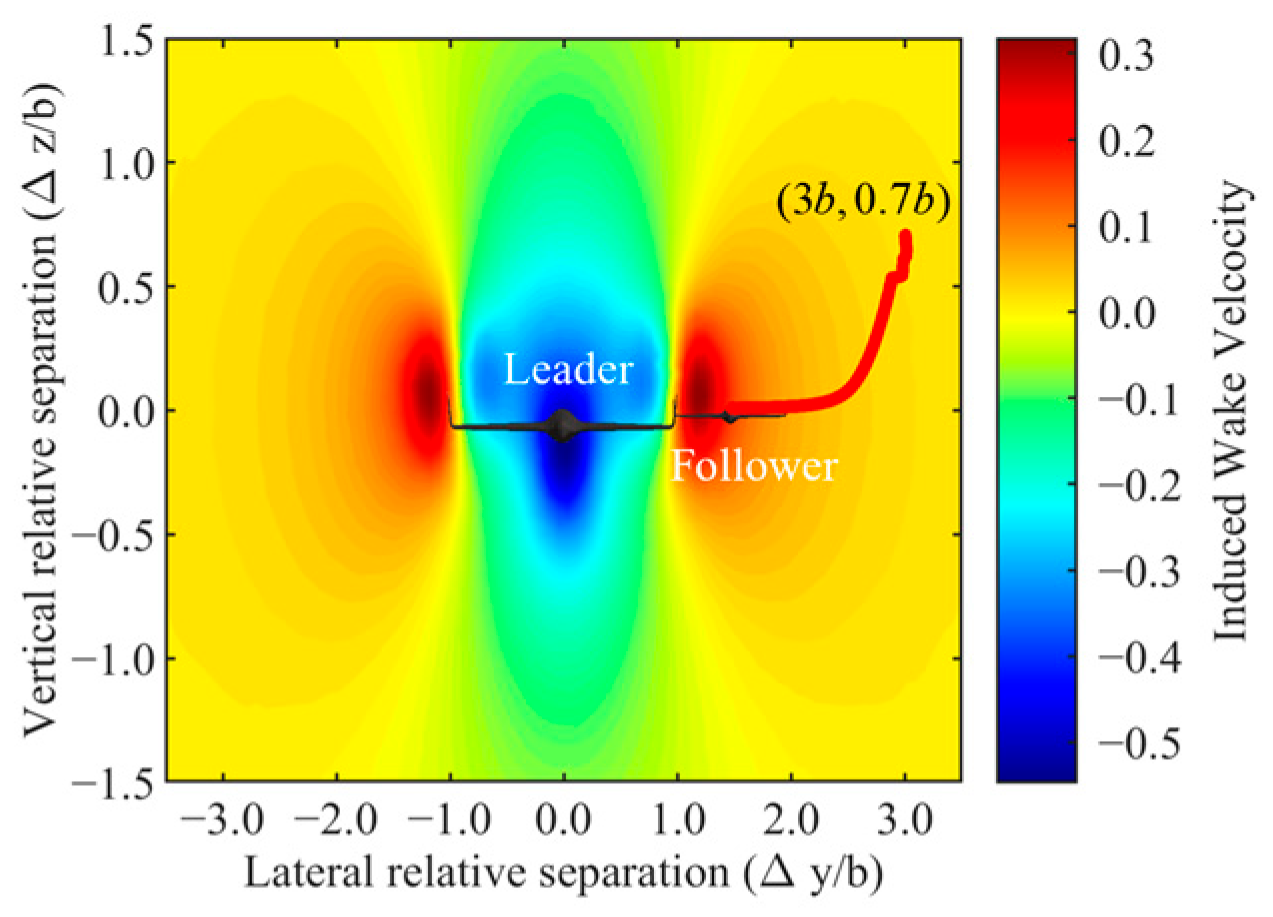

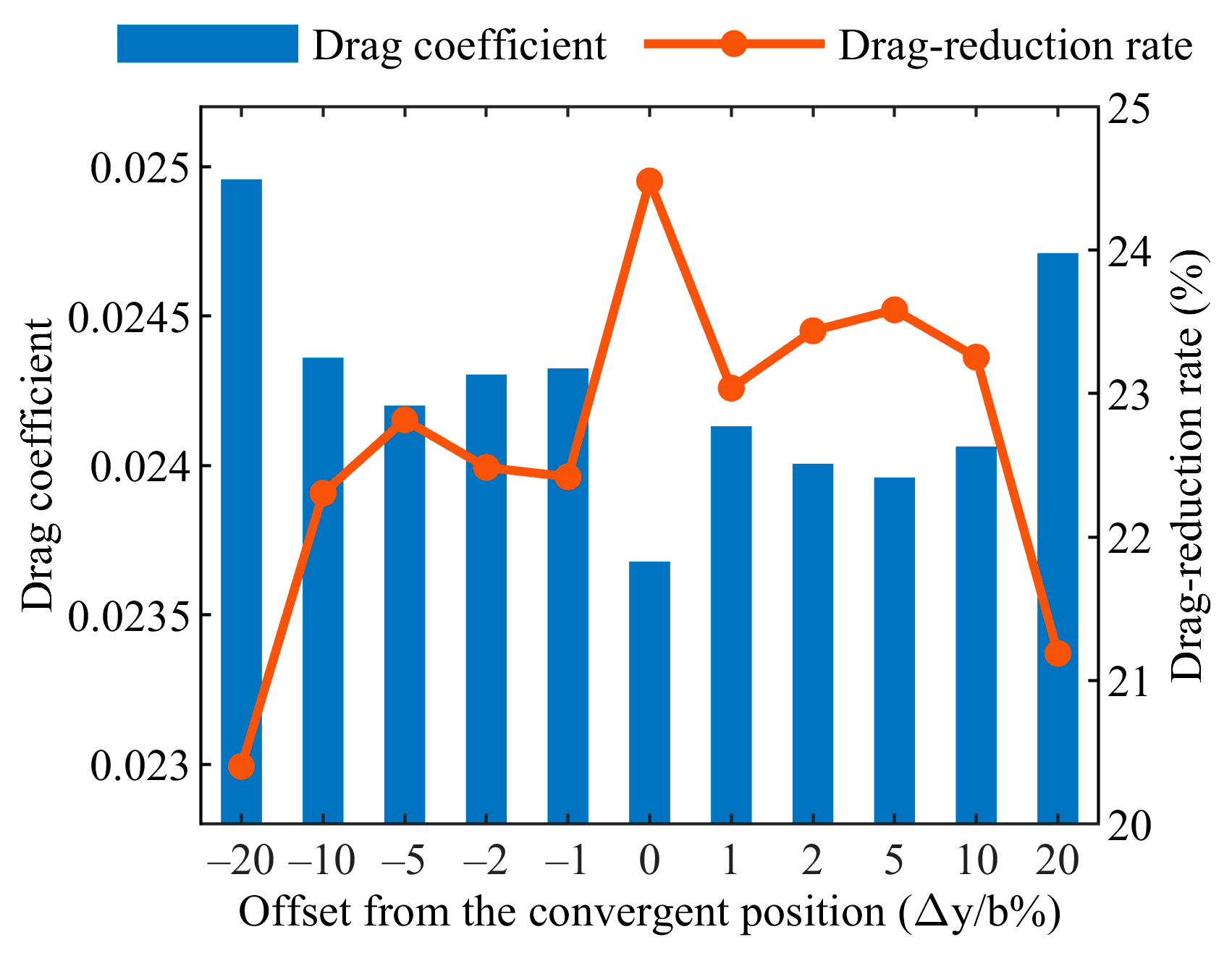
| Parameters | UAV |
|---|---|
| Span (m) | 2.1039 |
| Chord (m) | 0.4080 |
| Mass (kg) | 1.8404 |
| Wing Area (m2) | 0.7456 |
| Parameters | Large UAV | Small UAV |
|---|---|---|
| Span (m) | 4.2078 | 2.1039 |
| Chord (m) | 0.8160 | 0.4080 |
| Mass (kg) | 7.3616 | 1.8404 |
| Wing Area (m2) | 2.9824 | 0.7456 |
Disclaimer/Publisher’s Note: The statements, opinions and data contained in all publications are solely those of the individual author(s) and contributor(s) and not of MDPI and/or the editor(s). MDPI and/or the editor(s) disclaim responsibility for any injury to people or property resulting from any ideas, methods, instructions or products referred to in the content. |
© 2025 by the authors. Licensee MDPI, Basel, Switzerland. This article is an open access article distributed under the terms and conditions of the Creative Commons Attribution (CC BY) license (https://creativecommons.org/licenses/by/4.0/).
Share and Cite
Guo, T.; Ma, T.; Liu, H.; Fu, J.; Cheng, B.; Tao, L. Dynamic Estimation of Formation Wake Flow Fields Based on On-Board Sensing. Drones 2025, 9, 798. https://doi.org/10.3390/drones9110798
Guo T, Ma T, Liu H, Fu J, Cheng B, Tao L. Dynamic Estimation of Formation Wake Flow Fields Based on On-Board Sensing. Drones. 2025; 9(11):798. https://doi.org/10.3390/drones9110798
Chicago/Turabian StyleGuo, Tianhui, Tielin Ma, Haiqiao Liu, Jingcheng Fu, Bingchen Cheng, and Lulu Tao. 2025. "Dynamic Estimation of Formation Wake Flow Fields Based on On-Board Sensing" Drones 9, no. 11: 798. https://doi.org/10.3390/drones9110798
APA StyleGuo, T., Ma, T., Liu, H., Fu, J., Cheng, B., & Tao, L. (2025). Dynamic Estimation of Formation Wake Flow Fields Based on On-Board Sensing. Drones, 9(11), 798. https://doi.org/10.3390/drones9110798







